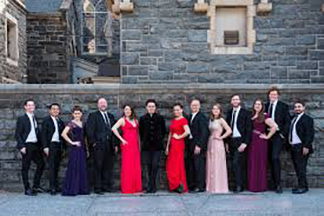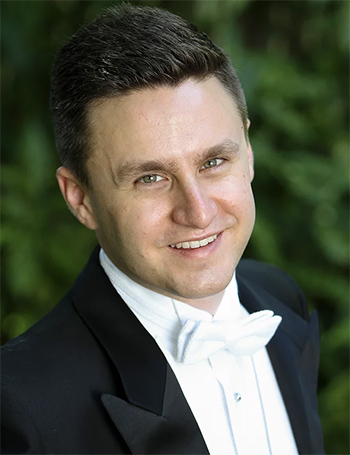by Daniel Hathaway

Robertson, based in Washington D.C., started his ensemble the better part of a decade ago with special repertory considerations in mind. “There are not many American professional choirs, and even fewer with an interest in singing all kinds of music,” he said in a recent telephone conversation. “My interests are more kaleidoscopic.”
Singers are drawn from a nationwide network of choral ensembles, chosen for each program based on the repertoire. And the name? Robertson, no triskaidekaphobiac, had America’s original colonies in mind in calling his ensemble The Thirteen Choir, but also found that twelve singers (plus himself) constituted the most practical format.
The Thirteen’s Cleveland program is fascinating. “It’s chiastic,” Robertson said. “Britten’s Hymn to St. Cecilia and Tallis’ votive antiphon Gaude gloriosa Dei Mater are the bookends. Both were written during turbulent times — Britten’s at sea while traversing U-boat-infested waters during World War II, Tallis’ during the brief reign of Mary when it was once again possible to write in the complex symphonic style of Tudor England. “The Britten, which sets poetry by W.H. Auden, is profound, whimsical, and touching. And not until the 20th century do we experience music that approaches Tallis’ level of virtuosity.”
The program continues with the Agnus Dei from William Byrd’s Mass for Four Voices, later paired with Ted Hearns’ setting from his Mass for St. Mary. “Ted is an American composer with many influences, and a wonderful complement to Byrd.”
Other pairs of pieces that speak to each other from opposite ends of the program are Meredith Monk’s Astronaut Anthem and Henry Purcell’s I was glad. “Monk looks at the broad idea of writing a wordless anthem in space, while Purcell is more earthy, expressing joy more than wonder.”
Just before intermission, Robertson has programmed a work by Caroline Shaw. “In Fly Away I, she juxtaposes improvisatory lines against a well-known hymn tune, popularized by Gillian Welch and Alison Krauss on the soundtrack to the Coen Brothers film O Brother, Where Art Thou?”

Matthew Robertson is no stranger to Northeast Ohio. He graduated from the Oberlin Conservatory in 2010, having studied conducting with Hugh Floyd, Bridget-Michaele Reischl, and Robert Spano, and organ with David Boe and Jack Mitchener. He returned to campus for the first time in the summer of 2018 to lead the chorus at the Oberlin Baroque Performance Institute.
The conductor ended our conversation saying that The Thirteen’s program on Wednesday will have something for everyone. “Our goal is to present two ends of the long line of English-language composers, and explore what binds us together as humanity, as well as what separates us through time.”
Published on ClevelandClassical.com October 22, 2019.
Click here for a printable copy of this article



